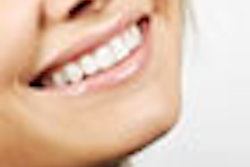Although replacing lost teeth often involves artificially building up the jaw, researchers at the University of Gothenburg are now showcasing a new method whereby teeth are instead moved into the toothless area using a brace, giving patients the chance of having more teeth.
In an experimental study on dogs, the Gothenburg researchers used a brace to move existing teeth into a toothless area with limited bone volume, without any reduction of the tooth's natural attachment in the mandible.
In a subsequent clinical study, orthodontist Birgitta Lindskog Stokland and her colleagues showed that the same procedure in humans caused only small changes in the tissue around the tooth.
"X-rays showed some root resorption, but this didn't seem to cause any lasting problems," she stated in a press release. "What's more, our follow-ups a year later showed that the damage had lessened."
The original site of the moved tooth suffers a reduction in bone mass and dental tissue volume, though not to the same extent as when teeth come out for other reasons, she added. This means that this area is well-suited to implants or other tooth replacements, without there being any need for bone transplants.



















